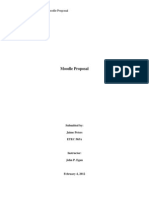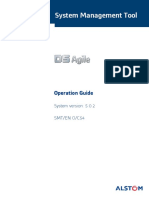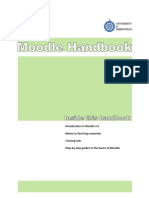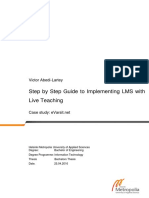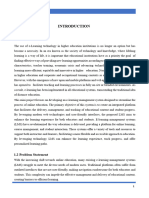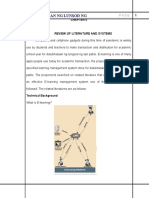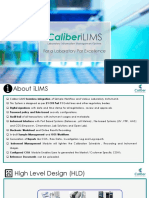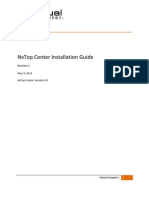Figure 1: Mlearning Architecture
Figure 1: Mlearning Architecture
Uploaded by
Anonymous xDP8yVyCopyright:
Available Formats
Figure 1: Mlearning Architecture
Figure 1: Mlearning Architecture
Uploaded by
Anonymous xDP8yVyOriginal Description:
Original Title
Copyright
Available Formats
Share this document
Did you find this document useful?
Is this content inappropriate?
Copyright:
Available Formats
Figure 1: Mlearning Architecture
Figure 1: Mlearning Architecture
Uploaded by
Anonymous xDP8yVyCopyright:
Available Formats
mLearning can be viewed as any form of teaching or studying that happens when the user is
interacting through a mobile device such as PDAs, mobile phones, laptops.
To improve current method of teaching, mobile learning (mLearning) using portable computing
devices (such as laptops, tablet PCs, PDAs, and smart phones) with wireless networks enables
mobility and mobile learning gives instructors and learners increased flexibility and new
opportunities for interaction. This report details the research made into the extension of Moodle
LMS which is MLE-Moodle that use J2ME. Also discussed are how the project was designed
and a detailed description of the implementation which includes class descriptions and
operations, steps taken in packaging the application, deployment of the package and how the
application was tested. The report concludes with an evaluation of the project specification and
whether the goals were met.
Figure 1: mLearning Architecture
The aim of this project paper is to introduce the mLearning environment to enhance conventional
method of teaching. By referring to the architecture above, student will use their java enables
mobile phones installed with MLE-Moodle client to connect to the Moodle platform server
reside at free web hosting, http://www.110mb.com. The messaging server will be the proxy
server used by the MLE to connect to the Internet with limited bandwidth and inexpensive
download costs, since the mobile client receives only the necessary data. Next, we will discuss
further more on implementing MLE-Moodle during classes.
Figure 2: mLearning Implemention in Classes Architecture
From above architecture show us the implementation of MLE-Moodle during classes. The
testing phase would be a choice activity where is start from the lecturer/instructor asks a question
and specifies a choice of multiple responses. Then it will be send directly to Moodle platform
server to be access by student using MLE-Moodle. It can be useful as a quick poll to stimulate
student thinking about the related topic to be taught and to allow the class to vote an answer for a
problem to be solved. After submitting, the result in percentage will be display on
lecturer/instructor laptop while in the mean time will be show on the white screen using LCD
projector so that lecturer/instructor can have a conversation for further action. By doing this, it
can improve the student and lecturer interactions where everyone will be participate.
Basically, the result shows that the main objective is achieved by construct the project in
implementing mLearning by using MLE-Moodle as a tool. The second objective to enhance
existing learning environment with mLearning be achieved when the project is completed.
Mainly, the instructor can implement new method of teaching by using pooling system to the
question given and also by using multimedia content to make class teaching to be more
interesting.
You might also like
- Dynamark Logging Protocol User Guide r01Document27 pagesDynamark Logging Protocol User Guide r01guisouza170895No ratings yet
- Final Module Teaching Technology in The Elementary GradesDocument18 pagesFinal Module Teaching Technology in The Elementary GradesEdlord MosterNo ratings yet
- EX200 Exam Dumps With PDFDocument7 pagesEX200 Exam Dumps With PDFprashant sharmaNo ratings yet
- Lms ProposalDocument6 pagesLms Proposalapi-247486256100% (1)
- Reference Paper 1 Sahana Murthy PDFDocument9 pagesReference Paper 1 Sahana Murthy PDFbennybenham100% (2)
- SMT EnO C54 GlobalDocument84 pagesSMT EnO C54 GlobalBalakrishnan KrishnanNo ratings yet
- Curfew E Pass Management System Project - 180540107175Document24 pagesCurfew E Pass Management System Project - 180540107175Shivam ViradiyaNo ratings yet
- Evaluating Usability in Learning Management System MoodleDocument6 pagesEvaluating Usability in Learning Management System MoodleAgung SupraptoNo ratings yet
- Test For TrailDocument14 pagesTest For TrailNikhil AravelliNo ratings yet
- Lms ProposalDocument2 pagesLms Proposalapi-239581752No ratings yet
- Modeling of Ades-Esp System: Suzana Marković, Ranko PopovićDocument5 pagesModeling of Ades-Esp System: Suzana Marković, Ranko PopovićСузана Вујовић МарковићNo ratings yet
- SOA Initiatives For ElearningDocument6 pagesSOA Initiatives For ElearningLee LikaNo ratings yet
- Cloud-Based Service For Ebooks Using EPUB Under The Aspect of Learning AnalyticsDocument7 pagesCloud-Based Service For Ebooks Using EPUB Under The Aspect of Learning AnalyticsMartinNo ratings yet
- Rift Valley LMS ProposalDocument16 pagesRift Valley LMS Proposaljohni eceNo ratings yet
- Cloud Computing Based E-Learning SystemDocument8 pagesCloud Computing Based E-Learning Systemannaicsdepartment100% (2)
- Online E-Learning Portal System Synopsis - RemovedDocument6 pagesOnline E-Learning Portal System Synopsis - RemovedSanjay H MNo ratings yet
- Teaching With Moodle in Higher EducationDocument8 pagesTeaching With Moodle in Higher EducationDr-Muhannad Al-ShboulNo ratings yet
- Chapter OneDocument7 pagesChapter OneabdallaNo ratings yet
- Journal Lewi Y71200010 - LMS Autoscaling With Google CloudDocument12 pagesJournal Lewi Y71200010 - LMS Autoscaling With Google CloudLewi S. KristiantoNo ratings yet
- LitReview Moodle LMSDocument10 pagesLitReview Moodle LMSFile VisaNo ratings yet
- Assignment 1 (LMS)Document6 pagesAssignment 1 (LMS)Nor Luqman Nor AliNo ratings yet
- All Episode EviDocument7 pagesAll Episode EviCaryll PondoyoNo ratings yet
- Online Testing Module in LMSDocument7 pagesOnline Testing Module in LMSservicesprovider110No ratings yet
- Adeleke Friend Chapter 3 NEWDocument9 pagesAdeleke Friend Chapter 3 NEWTobiloba TemitopeNo ratings yet
- Essay Pgt201eDocument13 pagesEssay Pgt201eLiah TambulianNo ratings yet
- Synopsis of The Smart E-Learning Management System-4Document59 pagesSynopsis of The Smart E-Learning Management System-4Morazy BlogNo ratings yet
- All Episode EviDocument7 pagesAll Episode EviCaryll PondoyoNo ratings yet
- The BEST e Learning PracticesDocument7 pagesThe BEST e Learning Practicesile_may91No ratings yet
- Moodle HandbookDocument46 pagesMoodle HandbookzmikulNo ratings yet
- Intext Activity_Ayson_Ken JoshuaDocument3 pagesIntext Activity_Ayson_Ken Joshuaken aysonNo ratings yet
- Edtc 6332 DesignguidefinalrevisedDocument35 pagesEdtc 6332 Designguidefinalrevisedapi-242537254No ratings yet
- 3 PBDocument17 pages3 PBVerushka Althea PlacidoNo ratings yet
- Elearning 2012Document25 pagesElearning 2012Babu RaoNo ratings yet
- Pembuatan Aplikasi Mobile Learning Sebagai Sarana Pembelajaran Di Lingkungan Universitas DiponegoroDocument11 pagesPembuatan Aplikasi Mobile Learning Sebagai Sarana Pembelajaran Di Lingkungan Universitas Diponegorobonar atausalahNo ratings yet
- TESDADocument50 pagesTESDAfarmbaluzoNo ratings yet
- Module 4 Lesson 1Document12 pagesModule 4 Lesson 1Trisha Mae CarriedoNo ratings yet
- E Learning DefinitionDocument42 pagesE Learning DefinitionChusnu Yuli Setyo0% (1)
- 479283.VsualisationeLearning Sbabic Vdavid IPogarcicFVDocument5 pages479283.VsualisationeLearning Sbabic Vdavid IPogarcicFVadetejubelloNo ratings yet
- Geeky Banker CAIIB IT MODULE C COMPLETEDocument54 pagesGeeky Banker CAIIB IT MODULE C COMPLETErutesh2021No ratings yet
- Teaching With Technology: Online Modules: DeliverableDocument4 pagesTeaching With Technology: Online Modules: Deliverableapi-279646568No ratings yet
- Becoming A Change Agent Through Professional DevelopmentDocument12 pagesBecoming A Change Agent Through Professional Developmentapi-744593881No ratings yet
- EDU 623 Final ProjectDocument15 pagesEDU 623 Final ProjectCara CaseNo ratings yet
- Name: Kurulekar Omprakash Jagannath Semester: Class: Final Year Practical NoDocument5 pagesName: Kurulekar Omprakash Jagannath Semester: Class: Final Year Practical Nodakhorekaran.engg7No ratings yet
- 1.1 Project Introduction: 1.1.1 Main ThemeDocument5 pages1.1 Project Introduction: 1.1.1 Main ThemeMuhammad NadeemNo ratings yet
- Full (Ebook PDF) Business Communication: Developing Leaders For A Networked World 3rd Edition Ebook All ChaptersDocument41 pagesFull (Ebook PDF) Business Communication: Developing Leaders For A Networked World 3rd Edition Ebook All Chaptersbalalaulloa100% (4)
- Learning Management System For LPU-LagunaDocument21 pagesLearning Management System For LPU-LagunaTeaNo ratings yet
- LmsDocument45 pagesLmsnalinagc100% (1)
- Lu 2015Document4 pagesLu 2015nikitakakajisonwaneNo ratings yet
- FYP Proposal LMSDocument9 pagesFYP Proposal LMSBilal KhokharNo ratings yet
- A Smart E-Learning System For Social Networking June1Document15 pagesA Smart E-Learning System For Social Networking June1Twinkle MounamiNo ratings yet
- Using ICTs in Teaching Elementary StudentsDocument6 pagesUsing ICTs in Teaching Elementary StudentsWei YiNo ratings yet
- Final Report BcaDocument48 pagesFinal Report Bcapruthvimgowda1997No ratings yet
- Final RevissionDocument136 pagesFinal RevissionShemeah SaldonNo ratings yet
- Moodle & E-Learning ToolsDocument8 pagesMoodle & E-Learning ToolsAndri HASNAwantoNo ratings yet
- ICT in EducationDocument6 pagesICT in EducationIzac Bane100% (1)
- Assistive Tools Towards Personal Learning Environment in Higher EducationDocument4 pagesAssistive Tools Towards Personal Learning Environment in Higher EducationShravan VanjariNo ratings yet
- Cloud Based Tools and ApplicationsDocument4 pagesCloud Based Tools and Applicationsapi-299424782No ratings yet
- The Contribution of M-Learning Applications To ImpDocument13 pagesThe Contribution of M-Learning Applications To ImpLuis BritoNo ratings yet
- A Critical Understanding of Learning Management System: Solomon Arulraj DAVIDDocument5 pagesA Critical Understanding of Learning Management System: Solomon Arulraj DAVIDSeminarski ProektniNo ratings yet
- A Strategy For Realization of Distance Learning System: DR Ružica Stanković DR Ranko PopovićDocument5 pagesA Strategy For Realization of Distance Learning System: DR Ružica Stanković DR Ranko PopovićСузана Вујовић МарковићNo ratings yet
- Elearn - Mini Project 1Document22 pagesElearn - Mini Project 1thunderffthunderff69No ratings yet
- Dalubhasaan NG Lunsod NG San Pablo: What Is E-Learning?Document26 pagesDalubhasaan NG Lunsod NG San Pablo: What Is E-Learning?Rem RemNo ratings yet
- Innovation Project PandemicsDocument11 pagesInnovation Project PandemicsannryNo ratings yet
- QRes LicenseDocument1 pageQRes LicenseAnonymous xDP8yVyNo ratings yet
- Cybx ModDocument2 pagesCybx ModAnonymous xDP8yVyNo ratings yet
- Non Motor Claims Notification GuideDocument18 pagesNon Motor Claims Notification GuideAnonymous xDP8yVyNo ratings yet
- EX200 Exam Dumps With PDF and VCE Download (Part B) PDFDocument22 pagesEX200 Exam Dumps With PDF and VCE Download (Part B) PDFAnonymous xDP8yVyNo ratings yet
- RedHat Practicetest Ex200 v2016!08!02 by Landon 15qDocument10 pagesRedHat Practicetest Ex200 v2016!08!02 by Landon 15qAnonymous xDP8yVyNo ratings yet
- The Relationship Between Further Training and Job SatisfactionDocument20 pagesThe Relationship Between Further Training and Job SatisfactionAnonymous xDP8yVyNo ratings yet
- Stress & Depression: Text Button BDocument3 pagesStress & Depression: Text Button BAnonymous xDP8yVyNo ratings yet
- Penny Wise, Pound Foolish: Govtech 2013 George AmblerDocument24 pagesPenny Wise, Pound Foolish: Govtech 2013 George AmblerTrung Nguyen NamNo ratings yet
- Synergetic Server Installation QuestionnaireDocument9 pagesSynergetic Server Installation QuestionnaireAAAAANo ratings yet
- RFP Part - I AP Urban Meeseva ProjectDocument69 pagesRFP Part - I AP Urban Meeseva ProjectSampath KumarNo ratings yet
- Mounting Cifs On AIX - Unix Linux Forums - AIX PDFDocument5 pagesMounting Cifs On AIX - Unix Linux Forums - AIX PDFsatNo ratings yet
- WebStation Specification Sheet 03-16025-01-EnDocument3 pagesWebStation Specification Sheet 03-16025-01-Enalawi747594No ratings yet
- Ler Development of An IoT System Using ESP8266 For 230307 212949Document6 pagesLer Development of An IoT System Using ESP8266 For 230307 212949Luiz Vinicius MagalhaesNo ratings yet
- Automatic Data Master ServerDocument19 pagesAutomatic Data Master ServerPlastik 1232No ratings yet
- 1.5 Automation Server DatasheetDocument6 pages1.5 Automation Server DatasheetGerman Sotero JimenezNo ratings yet
- Ingenuity Series / Brilliance 64Document407 pagesIngenuity Series / Brilliance 64Nelson J Silva A100% (1)
- Domino Server Tasks and Console CommandsDocument26 pagesDomino Server Tasks and Console Commandsvc_nishank8890No ratings yet
- C - CURE 9000 and iSTAR: Port AssignmentsDocument21 pagesC - CURE 9000 and iSTAR: Port AssignmentsRider hoyos fangNo ratings yet
- College ERP ProposalDocument10 pagesCollege ERP ProposalHari TiwariNo ratings yet
- CMX User GuideDocument222 pagesCMX User GuideRyan Anthony UmaliNo ratings yet
- Oracle EXALOGIC - Patching With ExaPatchDocument26 pagesOracle EXALOGIC - Patching With ExaPatchEva EspositoNo ratings yet
- Dell PowerProtect Data Manager VM Integration-Participant GuideDocument126 pagesDell PowerProtect Data Manager VM Integration-Participant GuideYousef JafariNo ratings yet
- Storegrid Offsite Backup SoftwareDocument362 pagesStoregrid Offsite Backup SoftwareAnonymous 10qlLhZFSTNo ratings yet
- Exclusive SAP Basis Training Book - WWW - SapdocsDocument56 pagesExclusive SAP Basis Training Book - WWW - SapdocsMohamed HelyesNo ratings yet
- PME EBO Integration Solution GuideDocument305 pagesPME EBO Integration Solution GuideVinicius Mello AlmeidaNo ratings yet
- MCSL-222 2024-25 emDocument21 pagesMCSL-222 2024-25 emAmit SharmaNo ratings yet
- FusionSphere V100R003C00 Quick Installation and Configuration Guide 01 PDFDocument33 pagesFusionSphere V100R003C00 Quick Installation and Configuration Guide 01 PDFJhony Alexander Duque100% (1)
- PIPENET VISION FLEXlm TroubleshootingDocument15 pagesPIPENET VISION FLEXlm Troubleshootingyadirs1No ratings yet
- Virtual Disk API ProgrammingDocument44 pagesVirtual Disk API ProgrammingFrancis HenryNo ratings yet
- Tale o Bulk A Pi Reference GuideDocument63 pagesTale o Bulk A Pi Reference GuideheasdstrongpeteNo ratings yet
- Caliber Ilims Features Flipbook PDF - CompressDocument34 pagesCaliber Ilims Features Flipbook PDF - CompressTanaspohorn Kaokaew100% (1)
- FI Material 2 NEWDocument569 pagesFI Material 2 NEWPrathamesh Parker100% (9)
- Real Time Bus Monitoring SystemDocument6 pagesReal Time Bus Monitoring SystemNelli HarshithaNo ratings yet
- NxTop Center Installation Guide Rev02Document27 pagesNxTop Center Installation Guide Rev02maxlen.santosNo ratings yet



